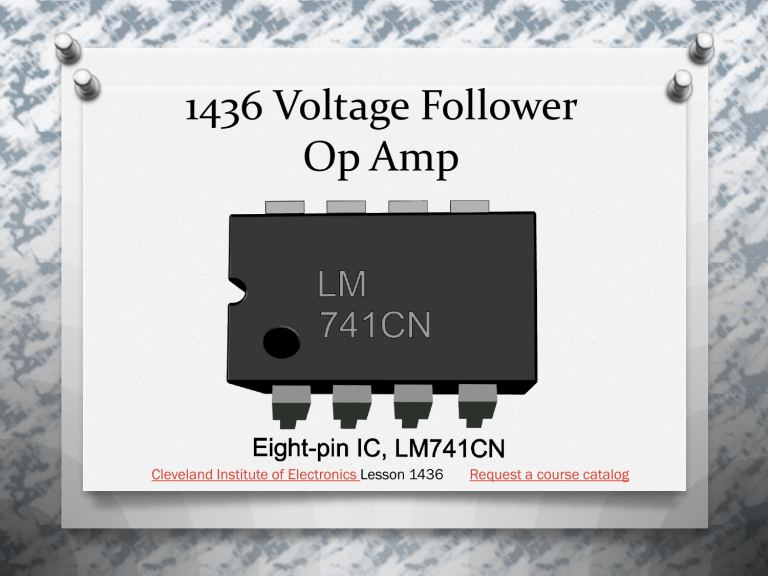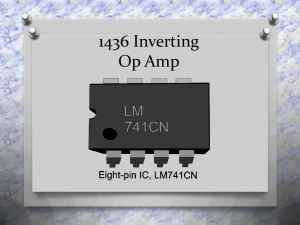1436 Voltage Follower Op Amp - Cleveland Institute of Electronics

1436 Voltage Follower
Op Amp
Cleveland Institute of Electronics Lesson 1436 Request a course catalog
Op Amp Amplifier Basics
O There are two basics forms in which an Op Amp (Operational
Amplifier) can be used as an amplifier :
O Inverting configuration
O Non-inverting configuration
741 DIP Pinout Diagram
Voltage Follower Op Amp
Schematic
Practical Considerations for the
741Voltage Follower Op Amp
O The input signal is applied to the non-inverting input
O Because of this, the output signal is not inverted or in phase with the input
O Inverting input is connected to the output pin of the Op Amp
O One assumption is the R
F
is zero Ω
O R1 is shown to be of infinite resistance
O This amplifier has unity gain and does not invert the phase of the input signal
O Unity gain means the gain is 1
O This also means you have a 1:1 ratio from the output to the input
O This also means what you put into the Op Amp is what you get out
O A
V
= 1 + R
F
/R
1
O A
V
= 1 + 0/∞ = 1
Practical Considerations for the 741 Operational Amplifier
O The input bias current is about 80 nA
O The input offset current is about 10 nA
O The input impedance is about
2 Meg Ohms
O The common mode voltage should be within +/-12V for +/-15V supply
O The output impedance is about 75 ohms.
O The voltage gain rolls off 6dB per octave starting at 100kHz.
O Maximum output Current: 20mA
O There is a finite input offset which must be zeroed by a resistor between pins 1 and 5. The input offset is typically 2mV to <6mV.
O The slew rate is 0.3V to 0.5V/ microsecond.
O There is some temperature dependence
O The voltage between the two input terminals of a normally operating Op
Amp is always zero volts.
O The maximum output-voltage swing of an Op Amp should ideally be equal to the value of the applied voltage.
O The actual maximum output swing of the 741 Op Amp is actually a little less than the theoretical maximum.
(Applied Voltage)
O The op amp will no longer operate linearly if you try to exceed this value
O The accuracy of the circuits to meet the calculated values is dependent on the actual values of the components used. (Values with their tolerances)
O Remember resistors have a tolerance.
O The calculated gain of the amplifier will very likely be different than the measured gain.
O This is also true for capacitors and pretty much any component manufactured by man.
Non-Inverting Amp Voltage Gain
O A
V
= 1 + R
F
/R
1
A
V
= 1 + 0/∞ = 1
O
Voltage Follower Voltage Gain
V
OUT
= V
IN
E
OUT
= E
IN
Additional Discussion
O The Voltage Follower provides impedance matching
O This means this Op Amp provides a high resistance to a signal source that would otherwise be severely loaded down by a low resistance value.
O As stated earlier, the output impedance is about 75 Ohms and can drive loads with relatively low resistance values.
O You will be applying both positive and negative voltages to the following voltage follower circuit.
O You should see the gain is 1 or unity and no phase inversion take place.
Unity Gain Op Amp Schematic
1436 Exp. 3 Ckt. 1 Constructed
1436 Exp. 3 Ckt 1 Close-up
Schematic for circuit 3 Exp. 2
1436 Exp. 3, Ckt. 2, Close-up
Meter Isolation Ckt for Ckt 2
QUESTIONS?
Resources
O Rosenow. (2001). Lesson 1436:
Operational amplifier characteristics .
Cleveland: Cleveland Institute of
Electronics.
The End
Developed and Produced by the Instructors in the CIE
Instruction Department.
© Copyright 01/2012
All Rights Reserved / Jan. 2012


